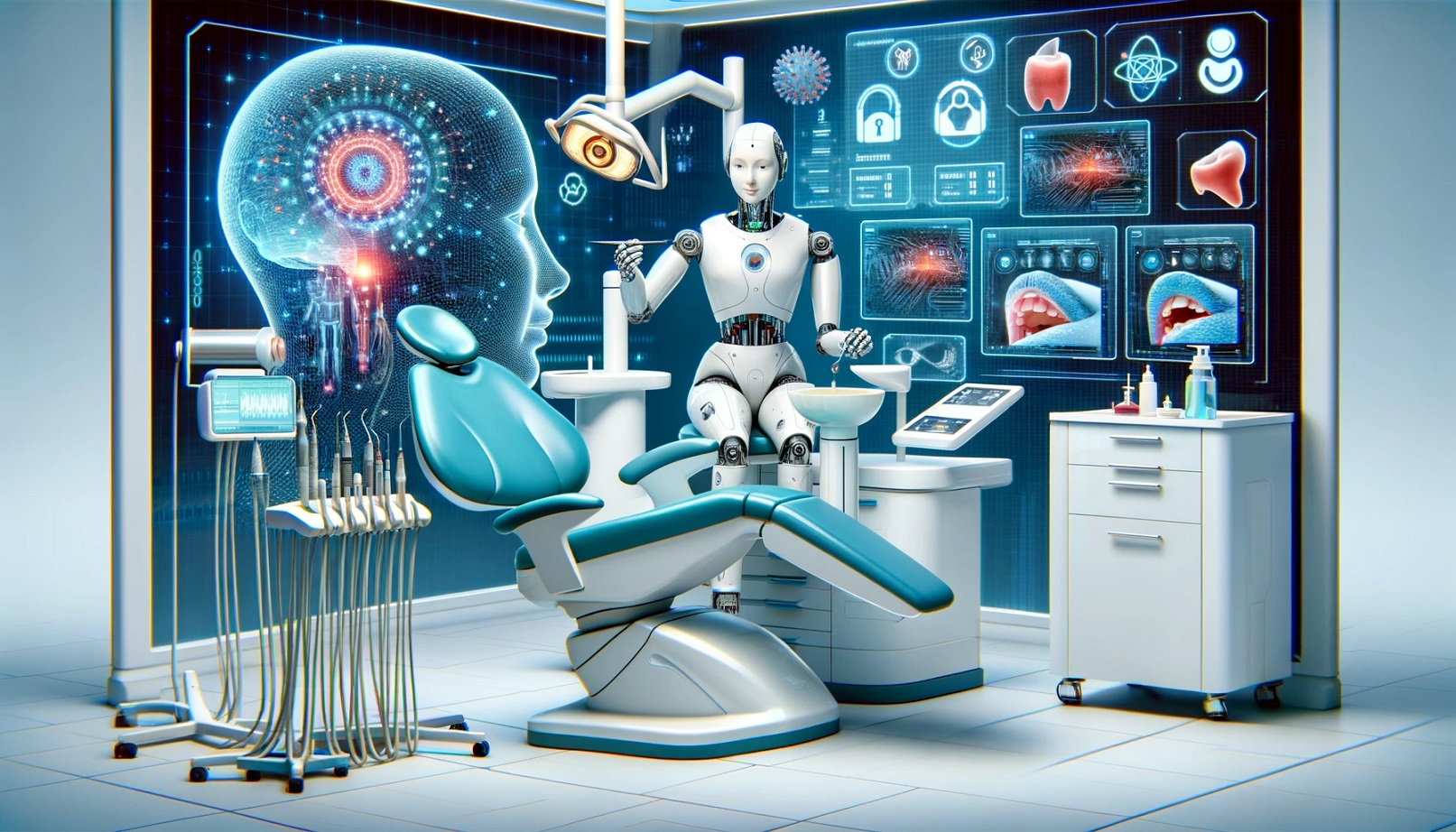Artificial Intelligence is rapidly transforming healthcare, and dentistry is no exception. In recent years, we've witnessed an unprecedented integration of AI into various aspects of dental practice, from diagnostic procedures and treatment planning to patient engagement and administrative tasks.
The technological revolution is not just about automation; it's about augmenting the capabilities of dental professionals, enhancing accuracy, improving patient outcomes, and opening new frontiers in dental research and education.
AI's journey in dentistry has been marked by significant milestones.
From using machine learning algorithms for analyzing dental images to developing sophisticated AI models for predicting treatment outcomes, the scope of AI's application in dentistry is vast and continually expanding.
These advancements are making dental procedures more efficient and contributing to more personalized and preventive dental care.
This article aims to provide a comprehensive and integrated perspective on the role of AI in dentistry.
To achieve this, we synthesize insights from three pivotal sources that collectively cover the spectrum of AI's application in the field. Each source brings a unique viewpoint:
General Overview of AI in Dentistry: We start by exploring the broad applications of AI across various dental disciplines, laying a foundation for understanding its impact on the field as a whole.
Ethical and Regulatory Aspects: Next, we delve into the ethical considerations and regulatory frameworks shaping AI's use in dentistry.
This includes standards and guidelines developed by authoritative bodies like the American Dental Association (ADA), ensuring that AI's integration into dental practice is responsible, safe, and patient-focused.
AI in Endodontics and Future Prospects: Finally, we focus on the specific use of AI in endodontics, illustrating how AI technologies are being utilized in this specialty. Additionally, we look at future advancements and challenges in integrating AI into dentistry.
AI in General Dentistry Practice
Overview of AI Applications in Dentistry
In general dentistry, AI has emerged as a transformative force, altering traditional practices and introducing new dimensions in patient care. Its applications span various domains:
- Diagnosis: AI algorithms significantly enhance diagnostic accuracy.
They analyze radiographs and intraoral images to detect pathologies such as caries, periodontal diseases, and oral cancers at earlier stages, surpassing conventional methods in both speed and precision. - Treatment Planning: AI systems assist in developing more efficient and effective treatment plans by analyzing a vast array of patient data, including past dental records, radiographic images, and even genetic information in some cases.
- Patient Care: AI-driven tools are used to personalize patient interactions, from providing customized oral hygiene recommendations based on individual risk assessments to answering patient queries through intelligent chatbots.
Classification of AI in Dentistry
AI in dentistry primarily employs two types of neural networks:
- Convolutional Neural Networks (CNNs): CNNs are particularly adept at processing visual imagery.
They are used extensively in analyzing dental radiographs and scans, where they can identify patterns and anomalies that might escape the human eye.
Their application in detecting minute changes in tooth structure, bone density, and even soft tissue anomalies is groundbreaking. - Artificial Neural Networks (ANNs): ANNs mimic the functioning of the human brain and are utilized in various aspects of dentistry.
These networks can process numerous data inputs, from patient medical histories to specific dental measurements, aiding in complex decision-making processes like predicting treatment outcomes or assessing the risk of certain dental conditions.
Impact on Clinical Practice
AI's integration into dental practices is already showing significant impacts:
- Enhanced Diagnostic Accuracy: With tools like CNNs, dentists can diagnose conditions more confidently, reducing the likelihood of misdiagnosis and ensuring timely intervention.
- Efficiency in Treatment Procedures: AI-driven predictive models help devise more effective treatment strategies, thus optimizing clinical time and improving patient outcomes.
- Customized Patient Experiences: AI's capability to analyze patient data thoroughly enables dentists to offer more personalized care. This not only improves treatment effectiveness but also enhances patient satisfaction.
- Training and Education: AI also revolutionizes dental education and training by providing simulation-based learning environments. These platforms allow dental students and practitioners to gain experience and practice skills in a risk-free, virtual setting.
In summary, AI's integration into general dentistry is not just an addition to the dentist's toolkit; it represents a paradigm shift in how dental care is delivered, experienced, and taught.
As AI continues to rise, its role in enhancing dental care's efficacy, precision, and personalization is expected to grow exponentially.
Ethical and Regulatory Considerations
ADA's Role and Guidelines
The American Dental Association (ADA) has been at the forefront of responsibly integrating AI into dentistry.
Recognizing the potential of AI, the ADA has been actively involved in setting standards to guide its ethical and practical use in dental practices. These efforts ensure that AI tools enhance dental care without compromising patient safety or professional integrity.
- Standard Development: The ADA has been working on creating comprehensive standards and technical reports related to AI in dentistry. This includes guidelines for image analysis systems using AI and augmented intelligence, ensuring these technologies are applied accurately and effectively.
- International Collaboration: The ADA is also instrumental in developing the U.S. position on international dental AI standards. By collaborating globally, the ADA aims to establish a unified approach to AI application in the dental field, promoting consistency and excellence in patient care worldwide.
Ethical Implications
The integration of AI in dentistry brings with it a range of ethical considerations that must be addressed:
- Patient Data Privacy: As AI systems often rely on large datasets, including sensitive patient information, protecting this data is paramount. Confidentiality and security are crucial in maintaining patient trust and adhering to legal privacy standards.
- Algorithmic Transparency: There is a need for transparency in how AI algorithms make decisions. This is important for maintaining trust among practitioners and patients and ensuring that these systems are free from biases that could affect patient care.
- Informed Consent: Patients must be informed about the use of AI in their treatment, including the benefits and limitations of these technologies. A fundamental ethical principle is ensuring that patients understand and consent to using AI in their care.
Regulatory Framework
The regulatory landscape for AI in dentistry is evolving to keep pace with technological advancements:
- Compliance with Health Regulations: AI applications in dentistry must comply with existing healthcare regulations, including those related to medical devices and patient data protection. Regulatory bodies are working to update these frameworks to better accommodate AI technologies.
- Quality and Safety Standards: Regulatory standards are being developed to ensure that AI tools in dentistry meet high-quality and safety benchmarks. This includes rigorous testing and validation of AI systems for clinical use.
- Professional Guidelines: Alongside governmental regulations, professional dental organizations are developing guidelines to help practitioners integrate AI into their practices responsibly. These guidelines cover ethical AI use, ongoing training, and patient communication.
In synopsis, the ethical and regulatory considerations surrounding AI in dentistry are complex and multifaceted. The ADA's role in setting standards and guidelines is critical in navigating these challenges. Ensuring that AI is used responsibly, ethically, and in compliance with regulatory standards is essential for its successful integration into dental practice.
AI in Endodontics and Future Trends

AI in Endodontics
Artificial Intelligence has carved a significant niche in the field of endodontics, revolutionizing traditional practices with its advanced capabilities:
- Root Canal Therapy: AI dramatically enhances the precision and effectiveness of root canal treatments. By analyzing detailed imagery, AI can accurately map out the complex anatomy of root canals, leading to more successful cleaning and filling procedures. It aids in detecting minute anatomical variations and pathologies that might be missed by conventional methods.
- Stem Cell Viability Predictions: AI is being used in the pioneering field of regenerative endodontics. It helps predict the viability of stem cells derived from dental pulp, which is critical for successful tissue regeneration. AI algorithms can analyze cellular data and predict outcomes of regenerative treatments, offering new avenues in endodontic therapies.
- Diagnosis and Treatment Planning: AI assists in diagnosing endodontic diseases by analyzing radiographs for signs of periapical lesions, root fractures, and other issues. It also aids in treatment planning by evaluating factors such as tooth anatomy, the extent of infection, and patient-specific data.
Future of AI in Dentistry
The potential future developments in AI for dentistry promise even more groundbreaking changes:
- Robotic Surgery: The future may see the introduction of robotic systems in endodontic surgeries. These AI-driven robots could perform precise surgical procedures, potentially increasing success rates and reducing patient recovery times.
- Advanced Diagnostic Tools: AI is expected to evolve into more sophisticated diagnostic tools, possibly integrating with emerging imaging technologies. This could lead to earlier detection of dental diseases, more accurate prognoses, and personalized treatment plans based on predictive modeling.
- Personalized Patient Care: AI might facilitate customized patient care by analyzing individual patient data over time. This could lead to developing personalized treatment protocols and preventive care strategies tailored to each patient's unique dental health profile.
- Integration with Dental Equipment: AI could be integrated more seamlessly with dental equipment, such as chairside monitors and intraoral scanners, providing real-time data analysis and decision support during procedures.
- Educational and Training Tools: In dental education, AI can play a significant role by providing simulation-based training tools, enabling students and practitioners to practice and refine their skills in a virtual environment.
AI's role in endodontics and its potential future developments point to a more technologically advanced, efficient, and patient-centered approach to dental care. As AI continues to evolve, it will likely become an integral part of the dental landscape, changing how endodontic care is delivered and experienced.
Practical Implications
For Dental Practitioners
- Integrating AI into Practice: Dental practitioners should start by familiarizing themselves with relevant AI technologies. This includes understanding how AI can enhance diagnostic accuracy, treatment planning, and patient management. Practitioners should seek training or workshops on AI applications in dentistry to stay updated.
- Choosing the Right AI Tools: Evaluate and select AI tools that are compliant with industry standards and have proven efficacy. Consider tools that integrate seamlessly with existing practice management software and digital imaging systems.
- Ethical Considerations: Ensure that any AI tool adheres to the ethical standards of bodies like the ADA. This includes respecting patient privacy, ensuring data security, and using AI responsibly to supplement, not replace clinical judgment.
- Continuous Learning: AI in dentistry is a rapidly evolving field. Practitioners should continuously learn and stay abreast of AI's latest developments, research, and best practices.
Patient Communication
- Educating Patients: Educate patients about using AI in their dental care. This includes explaining how AI aids in diagnosis, the accuracy of treatments, and improves overall care quality.
- Discussing Benefits and Limitations: Clearly communicate the benefits of AI, such as more precise diagnoses and personalized treatment plans, while being transparent about its limitations. It's important to reassure patients that AI tools are used to support, not replace, the dentist's expertise.
- Consent and Trust: Obtaining informed consent when using AI-driven procedures ensures that patients understand how their data is used and the role AI plays in their treatment. Building trust is crucial, so emphasize AI applications' safety, security, and benefits in dentistry.
- Addressing Concerns and Questions: Be prepared to answer questions and address patients' concerns about AI. This could include discussing data privacy, the accuracy of AI diagnoses, and how AI integrates with traditional dental care methods.
- Personalized Approach: Use AI to enhance the personalized care you offer. Explain to patients how AI analysis of their specific data leads to tailored treatment plans, potentially improving outcomes and patient satisfaction.
- Visual Aids and Examples: Utilize visual aids or case examples to illustrate how AI works and its benefits. This can help demystify AI technologies and make the information more accessible and understandable for patients.
Incorporating AI into dental practice requires technological integration and a commitment to ethical practice, continuous education, and effective communication with patients.
By doing so, dental practitioners can enhance the quality of care they provide while ensuring that their patients are well-informed and comfortable using advanced technology in their dental treatments.
Conclusion
This synthesis of information underscores the importance of a balanced approach to AI in dentistry.
As we integrate technological advancements, we must also consider ethical implications, ensuring that patient-centric care remains at the forefront.
AI should be seen as a tool to augment, not replace, the expertise of dental professionals, enhancing the quality and efficiency of care provided.
Furthermore, the dynamic nature of AI in dentistry necessitates ongoing research and development.
Recognizing this, our AI development services are specifically designed to support dental clinics, offering cutting-edge solutions that cater to the unique needs of this field.
Continuous collaboration among dental professionals, technologists, and regulatory bodies is vital to navigating the challenges and harnessing the full potential of AI in this field.
Such collaboration will drive innovation and ensure that advancements in AI are aligned with the best interests of patients and the profession's ethical standards.
In conclusion, AI presents a promising frontier in dentistry, offering opportunities to revolutionize various aspects of dental care.
However, its successful integration hinges on maintaining a harmonious balance between technological innovation and the core values of dental practice: patient well-being, ethical integrity, and professional excellence.
As we venture further into this era of digital dentistry, this balanced approach will define our success in harnessing AI for the betterment of dental care and patient outcomes.





